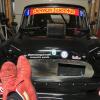Also, if anyone can explain how / why getting this mixed up is such a no no from a technical perspective that would be smashing.
Sorry, I've just read this bit now.
While the caps will usually fit over the studs (on a big bore engine) or step (on a small bore unit) either way, they only have one correct way of fitting back together.
When the Rods are manufactured, the meeting faces are first ground and then the tunnel (where the bearing shells fit) are machined and sized. The Bolts are usually 'off' one way or another and this can be for a number of normal manufacturing reasons but will only correctly line up one way only.
No doubt when you were assembling it, you noticed the small cut outs in the caps for the indexing of the bearing shells? These normally go to the same side. None the less, it's always wise to number the rods on disassembly and the caps at the same time and on the same side, so correct identification and orientation is readily (and universally) understood.
Also, sorry, but this does beg the question, when you were assembling the engine, you must have had to turn the crank a few times during the course of the build, if upon fitting bearing caps it was found hard to turn over (more usually from the caps being on back to front, they will lock up) it must have rung some alarm bells? Sure, it will get 'stiff' when the pistons are ~mid-bore due to the drag of the rings but as they get around TDC / BDC you can normally turn them by hand fairly easy.
Edited by Moke Spider, 05 November 2015 - 04:28 AM.
















